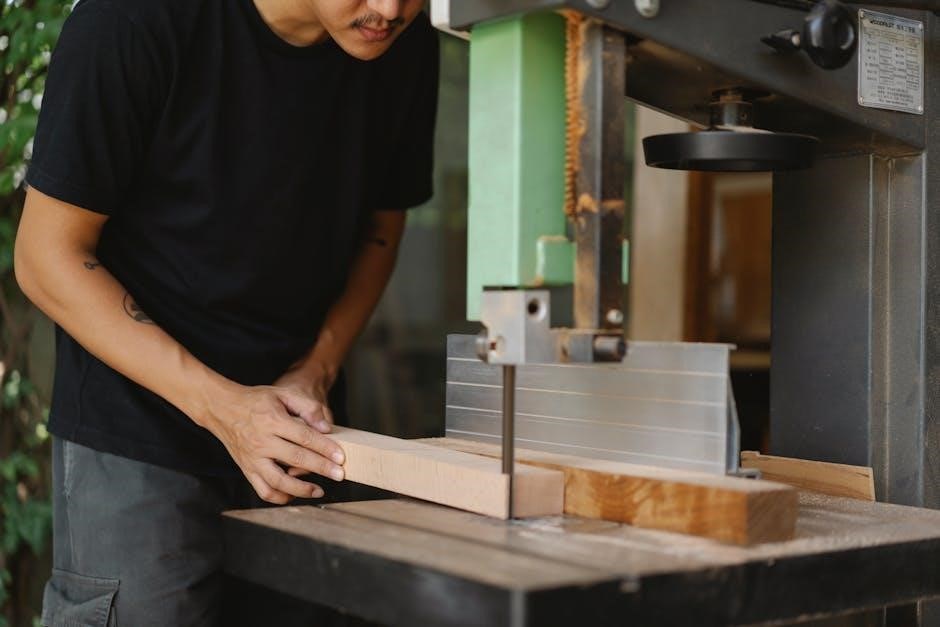Reciprocating Saw Guide Block: A Comprehensive Guide
Reciprocating saw guide blocks are essential accessories, enhancing cutting precision and safety. They help users achieve cleaner, straighter cuts in various materials. These blocks improve stability and reduce blade wandering for more professional results.
Reciprocating saws are versatile tools that can cut through various materials, but achieving precise and clean cuts can be challenging. This is where reciprocating saw guide blocks come into play. These blocks act as a support system, enhancing the saw’s stability and minimizing blade wandering, ultimately leading to improved accuracy. Guide blocks are particularly useful when cutting studs, pipes, or other materials where a straight and consistent cut is crucial. By providing a stable platform for the saw to rest against, guide blocks reduce the risk of errors and ensure that the blade follows the desired cutting path. Whether you are a professional tradesperson or a DIY enthusiast, incorporating a reciprocating saw guide block into your toolkit can significantly improve the quality and efficiency of your cutting tasks, making it an indispensable accessory for achieving professional-grade results with your reciprocating saw.
Types of Reciprocating Saw Guide Blocks
Reciprocating saw guide blocks come in various forms, each designed to cater to specific cutting needs. These include DIY blocks for simple tasks and commercial options for professional applications, differing in material and precision.
DIY Guide Blocks
DIY guide blocks offer a cost-effective solution for users who need occasional assistance with their reciprocating saw cuts. These blocks are often constructed from readily available materials, such as wood scraps, making them an accessible option for hobbyists and DIY enthusiasts. Their simplicity allows for customization, tailoring the guide to fit specific project requirements. However, DIY blocks may lack the precision and durability of commercially manufactured guides.
Creating your own guide block offers significant flexibility in terms of design and size. Users can adapt the block to accommodate unique cutting angles or material thicknesses, ensuring optimal performance for specific tasks. While they might not match the robustness of commercial options, DIY blocks provide a practical and budget-friendly alternative for enhancing cut accuracy and stability. Ensure secure attachment to the workpiece for safe operation.
Commercial Guide Blocks
Commercial guide blocks represent a professional-grade solution for reciprocating saw users seeking precision and durability. Unlike DIY alternatives, these blocks are manufactured to exacting standards, ensuring consistent performance and reliability. Constructed from robust materials like metal or high-density polymers, commercial guide blocks are designed to withstand rigorous use in demanding environments. Their engineered designs often incorporate features such as adjustable clamps or specialized grooves to enhance stability and accuracy during cuts.
Investing in a commercial guide block provides several advantages, including improved cutting precision, increased safety, and extended lifespan. These blocks minimize blade wandering, resulting in cleaner, straighter cuts, and reduce the risk of kickback or other accidents. While they may come at a higher initial cost than DIY options, their superior performance and longevity make them a worthwhile investment for professionals and serious hobbyists alike. They often include features for quick setup and adjustments.

Materials Used in Guide Blocks
Reciprocating saw guide blocks are crafted from various materials to suit diverse applications and budgets. Common choices include metals for durability and wood for affordability and ease of customization, each offering unique benefits.
Metal Guide Blocks
Metal guide blocks represent a robust and durable option for reciprocating saw users seeking precision and longevity. Typically constructed from steel, stainless steel, or aluminum, these blocks offer exceptional resistance to wear and tear, making them suitable for demanding applications and frequent use. The inherent strength of metal ensures that the guide block maintains its shape and structural integrity, even under significant pressure or stress during cutting operations.
Metal guide blocks provide enhanced stability, minimizing blade deflection and vibration. This leads to cleaner, more accurate cuts, particularly when working with metal pipes or studs. Metal’s heat resistance prevents deformation, preserving accuracy over time, while the weight can aid stability.
Considerations include potential for scratching surfaces, higher cost, and need for rust-resistant coatings. However, for professionals and serious DIYers, metal guide blocks are a worthwhile investment.
Wood Guide Blocks
Wood guide blocks offer a cost-effective and easily customizable solution for reciprocating saw users. Often crafted from readily available materials like plywood, hardwood, or even reclaimed lumber, they present an accessible option for DIY enthusiasts and those seeking a temporary or project-specific guide.
The primary advantage of wood guide blocks lies in their ease of fabrication. Users can quickly create custom shapes and sizes to accommodate unique cutting needs. Wood’s inherent softness also minimizes the risk of scratching or damaging delicate workpieces.
However, wood guide blocks are less durable than their metal counterparts and may not withstand prolonged or heavy use. They are susceptible to wear, moisture damage, and deformation under pressure. Accuracy can be compromised over time as the wood degrades. Despite these limitations, wood guide blocks serve as a practical and economical choice for occasional tasks and experimental setups.

Benefits of Using a Guide Block
Guide blocks enhance reciprocating saw performance, delivering improved cutting accuracy and consistency. Safety is also increased, as guide blocks minimize blade wandering. Overall, they offer better control and reduce the risk of accidents.
Improved Accuracy
Achieving precise cuts with a reciprocating saw can be challenging without assistance. The flexible blade tends to wander, especially when initiating cuts or working with denser materials. A guide block significantly enhances accuracy by providing a stable reference point.
By keeping the blade aligned along the intended cut line, the guide block minimizes deviations and ensures straighter, cleaner results. This is particularly useful for tasks requiring tight tolerances or when aesthetics matter. Whether cutting studs, pipes, or other materials, using a guide block helps to achieve professional-quality cuts.
Furthermore, improved accuracy leads to reduced material waste, saving both time and resources. Projects benefit from cleaner joints and more precise fits, enhancing the overall quality of finished work. For both DIY enthusiasts and professionals, a guide block is an indispensable tool for achieving accurate cuts with a reciprocating saw.
Enhanced Safety
Operating a reciprocating saw can pose risks, especially when dealing with unstable materials or awkward cutting angles. A guide block significantly enhances safety by providing a stable platform and reducing the likelihood of accidents. By keeping the blade aligned, it minimizes the chance of kickback or uncontrolled movements.
The guide block also helps to maintain a safe distance between the user’s hands and the blade, preventing potential injuries. This is particularly important when working in tight spaces or with materials that require a firm grip. Additionally, the guide block reduces vibration, minimizing user fatigue and improving control over the saw.
Enhanced safety features contribute to a more confident and efficient work environment. Users can focus on the task at hand without worrying about potential hazards, resulting in improved productivity and reduced risk of accidents. For both novice and experienced users, a guide block is an essential accessory for safe reciprocating saw operation.

Applications of Reciprocating Saw Guide Blocks
Reciprocating saw guide blocks are versatile, offering solutions for various cutting tasks. They enhance precision in demolition, plumbing, and construction projects. These blocks ensure cleaner, safer cuts across different materials and applications.
Cutting Studs
Cutting studs accurately is crucial in framing and construction, and reciprocating saw guide blocks offer a significant advantage. When modifying existing walls or building new structures, achieving precise stud cuts is essential for structural integrity. A guide block ensures that the reciprocating saw blade remains perpendicular to the stud, preventing angled or uneven cuts.
Using a guide block simplifies creating a square, clean cut, which is particularly useful when fitting headers into existing walls. By providing a stable and consistent cutting path, the guide block minimizes blade wandering, a common issue when freehanding with a reciprocating saw. This method reduces the likelihood of errors, saving time and material.
The guide block also enhances safety by reducing the risk of kickback and improving control over the saw. This makes the process more manageable for both experienced and novice users; With a guide block, cutting studs becomes a more predictable and reliable task, essential for quality construction.
Pipe Cutting
Reciprocating saws are commonly used for pipe cutting, but achieving clean, square cuts can be challenging without the right tools. A guide block designed for pipe cutting provides stability and ensures the blade remains perpendicular to the pipe’s axis. This is especially crucial for plumbing and construction projects where precise pipe alignment is necessary.
Using a guide block minimizes vibrations and reduces the risk of the blade wandering, leading to cleaner and more accurate cuts. The guide block also helps to maintain consistent pressure, preventing the blade from binding or snagging. This results in smoother cuts and reduces wear on the blade.
Some commercial guide blocks are specifically designed for pipe cutting, featuring adjustable clamps and secure locking mechanisms. These guides often accommodate different pipe sizes, making them versatile for various projects. Additionally, using a guide block enhances safety by keeping the saw stable and reducing the chance of accidents. This makes pipe cutting with a reciprocating saw more efficient and reliable.

Choosing the Right Guide Block
Selecting the correct guide block involves assessing material compatibility and ensuring a proper fit for your reciprocating saw. Consider the specific applications and the materials you’ll be cutting to optimize performance and safety.
Material Compatibility
When selecting a reciprocating saw guide block, material compatibility is paramount. Different materials require specific guide block compositions to ensure optimal performance and longevity. For instance, metal guide blocks excel when cutting metallic pipes or studs, offering durability against abrasive materials. Wood guide blocks are suitable for woodworking tasks, providing a softer interface that minimizes damage to the workpiece.
Consider the materials you frequently cut. Abrasive materials like brick, stone, or stucco necessitate robust guide blocks resistant to wear. Conversely, delicate materials like plastics or softwoods benefit from guide blocks that prevent scratching or marring.
Always consult the manufacturer’s guidelines to ensure compatibility between the guide block material, the saw blade, and the workpiece. Selecting the correct material enhances cutting precision and extends the lifespan of both the guide block and the saw blade.
Size and Fit
Selecting the right size and ensuring a proper fit are crucial for a reciprocating saw guide block to function effectively. The guide block must accommodate the width and thickness of the reciprocating saw blade being used. A loose fit can lead to blade wobble, reducing cutting accuracy and potentially causing damage to the workpiece.
Conversely, a guide block that is too tight can bind the blade, increasing friction and heat, which may result in premature wear or blade breakage. Measure the blade’s dimensions accurately before choosing a guide block.
Consider the size of the materials you typically cut. Larger diameter pipes or thicker studs may require guide blocks with wider openings. Ensure the guide block fits securely onto the workpiece, providing a stable platform for the saw. Adjustable guide blocks offer versatility, accommodating various blade sizes and material thicknesses, making them a practical choice for diverse cutting applications. Prioritize a snug, but not restrictive, fit for optimal performance.
Tips for Using Guide Blocks Effectively
To maximize the benefits of using guide blocks with your reciprocating saw, several key techniques should be followed. First, always ensure the guide block is securely attached to the material being cut. This prevents movement during operation, maintaining accuracy. Verify the blade is properly aligned within the guide block to avoid uneven cuts.
Use consistent pressure and a slow, controlled cutting speed to allow the blade to effectively remove material. Avoid forcing the saw, as this can cause the blade to bend or break. Lubricate the blade regularly, especially when cutting metal, to reduce friction and heat.
Inspect the guide block for wear or damage before each use, replacing it if necessary. For angled cuts, utilize adjustable guide blocks or custom-made jigs to achieve the desired angle. Practice on scrap material to get a feel for the guide block and saw combination before tackling critical projects. Always wear appropriate safety gear, including eye protection and gloves.
